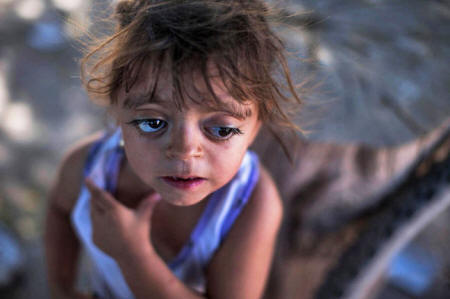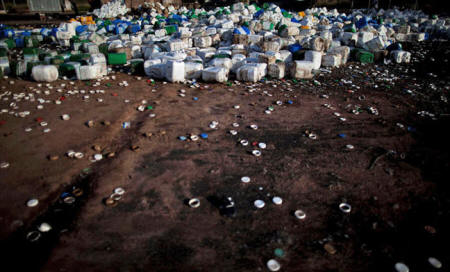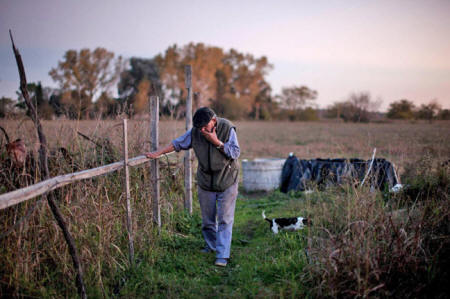|

by Vic Bishop
December 01, 2015
from
WakingTimes Website
Spanish version

Camila Veron,
2, born with multiple organ problems and severely disabled,
stands outside her
home in Avia Terai, in Chaco province, Argentina, March 31, 2013.
Her mother was told,
"the water made this happen because they spray a lot of poison
here."
CREDIT: Natacha Pisarenko/AP
Argentinean "farm belt" communities with
population of 12 million people know, perhaps more than others, the
costs of becoming one of the early adopters of Monsanto's biotech
farming model.
The country, historically known for its
grass-fed beef industry, has undergone a profound change over the
last 20 years as it transitioned into becoming one of the biggest
world producers of
genetically-modified (GM)
soybeans.
In 1996,
Monsanto came in with its promises
of higher crop yields and lower pesticide use, selling its GM soy
seeds, as well as corn and cotton seeds.
The farming communities took to these
promises only to find themselves using nine times more agrochemicals
by 2013 at a combined 84 million gallons per year, compared to nine
million gallons in 1990, and faced with a surge of health problems
such as
hypothyroidism, chronic respiratory
illnesses
and cancer.
Agrochemicals are now routinely found in homes, schools and drinking
water nearby soy, cotton and corn fields. They are handled inside
residential neighborhoods with little training or compliance
regarding protective gear and mixing concentrations.
Pesticide storage containers are often
reused in farming communities, at times to even hold drinking water.

Empty agrochemical
containers lay discarded
at a recycling center
in Quimili,
Santiago del Estero
province, Argentina, May 2, 2013.
CREDIT: Natacha
Pisarenko/AP
Although spraying herbicides and pesticides next to residential
homes and schools is forbidden in many Argentinean provinces, the
reality is that most laws regarding agrochemical usage are ignored
and their enforcement is lackadaisical, at best.
Some provinces allow spraying as close
as 55 yards from populated areas, and about one-third of the
provinces have no limits whatsoever. There are many documented cases
where GM crops are planted just a few feet away from homes and
classroom windows, resulting in chemical spray drifting into schools
full of children and into family homes.
With soybeans selling for about $500 a ton, growers plant where they
can, often disregarding Monsanto's guidelines and provincial law by
spraying with no advance warning, and even in windy conditions.
"I prepared millions of liters of
poison without any kind of protection, no gloves, masks or
special clothing," he said. "I didn't know anything. I only
learned later what it did to me, after contacting scientists."
[Source]
A collective of doctors and scientists
are now actively warning against the uncontrolled use of
agrochemicals.
These professionals believe that the
chemicals are responsible for a surge in health problems in farming
communities and around the country.
"The change in how agriculture is
produced has brought, frankly, a change in the profile of
diseases. We've gone from a pretty healthy population to one
with a high rate of cancer, birth defects, and illnesses seldom
seen before."
Dr. Medardo Avila Vazquez,
a pediatrician and neonatologist
who co-founded Doctors of Fumigated Towns,
part of a growing movement
demanding enforcement of agricultural safety rules
The Associated Press documented dozens
of cases where agrochemicals were used unsafely and the resulting
impact on families and communities, many of them reflected in the
images below.

Former farmworker
Fabian Tomasi, 47, of Basavilbaso, in Entre Rios
province, Argentina, on March 29, 2013. Tomasi
suffers from polyneuropathy. "I prepared
millions of liters of poison without any kind of
protection, no gloves, masks or special
clothing. I didn't know anything. I only learned
later what it did to me, after contacting
scientists," he said.
CREDIT: Natacha Pisarenko/AP

Students ride a
motorbike past a field of biotech corn on their
way to school in Pozo del Toba, Santiago del
Estero province, Argentina, May 3, 2013.
CREDIT: Natacha Pisarenko/AP

Locals wait to speak
with Dr. Damian Verzenassi about health concerns
they have about agrochemicals in the main square
of Alvear, in Santa Fe province, Argentina,
March 9, 2013.
CREDIT:
Natacha Pisarenko/AP

Aixa Cano, 5, who
has hairy moles all over her body, sits on a
stoop outside her home in Avia Terai, in Chaco
province, Argentina, April 1, 2013. Doctors say
Aixa's birth defect may be linked to
agrochemicals, although this cannot be proven.
In Chaco, children are four times more likely to
be born with devastating birth defects since the
biotechnology boom.
CREDIT: Natacha Pisarenko/AP

Silvia Alvarez leans
against her home while keeping an eye on her
son, Ezequiel Moreno, who was born with
hydrocephalus, in Gancedo, in Chaco province,
Argentina, April 1, 2013. Chaco provincial birth
reports show that congenital defects quadrupled
in the decade after GM crops arrived.
CREDIT: Natacha Pisarenko/AP

Activist Oscar
Alfredo Di Vincensi has been fighting that
agrochemical spraying not be allowed within
1,000 meters of homes. Pictured here in the main
square of Alberti, in Buenos Aires province,
Argentina, April 16, 2013. Di Vincensi stood in
a field waving a court order barring spraying
within 1,000 meters of homes in his town of
Alberti; a tractor driver doused him in
pesticide.
CREDIT:
Natacha Pisarenko/AP

Erika, left, and her
twin sister Macarena, who suffer from chronic
respiratory illness, play in their backyard near
recycled agrochemical containers filled with
water that is used for flushing their toilet,
feeding their chickens and washing their
clothes, near the town of Avia Terai, in Chaco
province, Argentina, on March 31, 2013.
CREDIT: Natacha Pisarenko/AP

Felix San Roman
walks on his property in Rawson, in Buenos Aires
province, Argentina, April 16, 2013. San Roman
was beaten by farmers when he complained about
clouds of chemicals drifting onto his property.
"This is a small town where nobody confronts
anyone, and the authorities look the other way.
All I want is for them to follow the existing
law, which says you can't do this within 1,500
meters. Nobody follows this. How can you control
it?" he said.
CREDIT:
Natacha Pisarenko/AP
Glyphosate is listed as one of the
world's 'safest' herbicides, which has resulted in farmers
using it in higher concentrations and mixing it with other harmful
poisons.
The Argentinean government has relied on industry
research provided by
the EPA to help guide its
recommendations regarding glyphosate use.
On their website, the EPA states,
"Glyphosate has low toxicity for humans.
Protective eye wear is recommended for the few products that may
cause eye irritation. Entry into agricultural fields is allowed
12-hours after application of these products."
Hence, any efforts or recommendations towards
stricter regulations in Argentina continue to fizzle out or have
been completely ignored.
Glyphosate mixed with other agrochemicals continues
to be applied directly to crops on a vast scale throughout the
country.
Molecular biologist Dr. Andres Carrasco at
the University of Buenos Aires says the burden from the chemical
cocktails is worrisome, but even glyphosate alone could spell
trouble for human health.
He found that injecting a very low dose of
glyphosate into embryos can change levels of retinoic acid,
causing the same sort of spinal defects in frogs and chickens
that doctors increasingly are registering in communities where
farm chemicals are ubiquitous.
This acid, a form of vitamin A, is fundamental for keeping
cancers in check and triggering genetic expression, the process
by which embryonic cells develop into organs and limbs.
|











